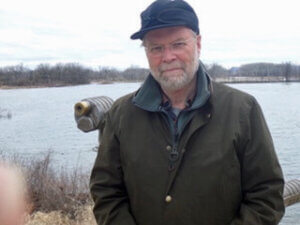Friends of River Marsh protect wetlands
June 8, 2024
| By La Crosse Community Foundation |
La Crosse River Marsh, an important local resource

As president of the board of directors for Friends of the La Crosse River Marsh, Chuck Lee will tell you relationships are key to protecting environmental treasures like the marsh.
Based at the confluence of the La Crosse and Mississippi Rivers is a thousand-acre ecological gem: the La Crosse River Marsh. The marsh supports a diverse range of wildlife and vegetation while providing cleaner water, recreational opportunities and critical flood mitigation for the city of La Crosse. Protecting this precious resource is Friends of the La Crosse River Marsh, a nonprofit group dedicated to preserving, enhancing, and educating the rest of us about this vital wetland.
Chuck Lee, who serves as president of the board of directors for Friends of the La Crosse River Marsh, will be the first to tell you their mission comes to life through the collaboration and support of a network of public and private partners, nonprofit organizations, members, and the irreplaceable efforts of volunteers. Theirs is yet another story highlighting the role of relationships and social capital in protecting our shared environmental heritage.
What is the marsh’s role in our local ecosystem, and what are some unique challenges in conserving it?
The marsh is a riparian wetland uniquely associated with the La Crosse, Black, and Mississippi rivers. It serves many functions within our region. It stores floodwater. It is a rich, biodiverse environment. It includes regionally important Northern Pike spawning pools. It’s a stopover on the Mississippi River spring and fall migration routes. Tundra swans, white pelicans, sandhill cranes, Canada geese, green herons, numerous waterfowl, warblers, and others — the rare Bell’s vireo — visit or call the marsh home. This year, there are five bald eagle nests in or near the marsh. Daily, one can see beaver, muskrat, river otter, and red fox. Blanchard’s cricket frog, an extremely rare, endangered frog in Wisconsin, can be heard in the marsh. Blanding’s turtle, also rare in Wisconsin, inhabits the marsh. Still, while not unique to the marsh, climate change poses fundamental issues for our preservation work. Dramatic changes in seasonal weather cycles, years of high water, the death of canopy-level trees — there is no new normal. Finally, it’s an urban wetland, and as such, it occupies a contested ecological niche.
What role have community relationships and partnerships played in your work to conserve the marsh? And how have they impacted your conservation efforts?
Our protection and restoration work in the marsh is done with the understanding of the City of La Crosse Parks, Recreation and Forestry Department and the Wisconsin Department of Natural Resources. We help maintain the recreational trails, trimming overhanging vegetation and planting native trees and shrubs. We work with WisCorps and our member volunteers to control the growth of invasive trees and shrubs like buckthorn and honeysuckle. Together with The Nature Place, we offer monthly environmental programs. In association with The Sustainability Institute and Earth Fair, we conduct an annual marsh clean-up. UW-L students and student-athletes are enormously helpful with the clean-up work. With our membership, the Mississippi Valley Conservancy, and the Sustainability Institute, we schedule and lead guided walks in the marsh. Finally, we are engaged with the city in long-range restoration planning for hydrology, habitat, and trails. These are community-wide partnerships.
What’s the most unusual or amazing wildlife you’ve seen at the marsh?
I first joined with others to preserve the marsh in 1988 and have been at it ever since. I am still thrilled every spring when I see or hear the sandhill cranes return to the marsh. White pelicans are amazing in flight and on the water. I’ve seen grey fox for the first and only time in the marsh and beaver, with their lodges and dams, nature’s wetland architects.

